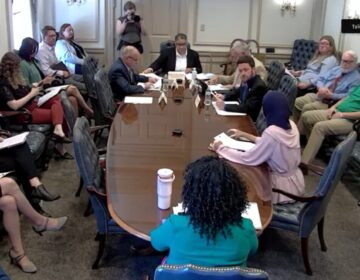How the 2010 Census can reshape Philadelphia

March 24, 2010
By Elise Vider
For PlanPhilly
For Philadelphia, the 2010 Census shares similarities with both a political campaign and a sports rivalry, with a little something extra thrown in for policy wonks and statisticians. Yet the results will steer planning and potentially shape the physical character of the city for years to come by providing an accurate, block-by-block snapshot of the population and a basis for public and private investment and decision making.
Census findings will provide the underpinning for Philadelphia’s just started comprehensive plan, the city’s first in 50 years. The 1960 plan, notes Alan Greenberger, acting deputy mayor for planning and economic development, made incorrect assumptions about population growth, predicting a city that would grow to 2.5 million. “Based on that prediction, we built a lot of public facilities for a city that is now at 1.5 million,” he says. It is not a mistake the city can afford to make again.
The immediate mission for the Nutter administration’s Philly Counts! get-out-the-count effort, according to Executive Director Patricia Enright, “is to prove once and for all that the city of Philadelphia is growing again.” In fact, the Census Bureau has already conceded the point.
Based on its own analyses, the Philadelphia City Planning Commission challenged the official 2008 federal estimate that reported continued population loss. (Philadelphia’s population peaked in 1950 at just over two million and has dropped steadily with each decennial census since.) The Commission convinced the feds that the city’s population had grown by 93,000 since 2000, bringing Philadelphia’s new official 2008 population to 1,540,351. See PlanPhilly coverage.
The new number inched Philadelphia past Phoenix’s 1.525 million population, tenuously reinstating our supremacy as the country’s fifth largest city.
But much more is at stake than whupping Phoenix. Even aside from the critically important issues of redrawing legislative districts and apportioning representation in Congress and the Electoral College, census data determines the flow of hundreds of billions of federal dollars and provides cities with the data essential to best use those funds. For the public sector, census data informs housing and economic development policies, guides public works and capital expenditures. For the private sector, it can drive investment from corporate relocations to a new corner, mom-and-pop.
“Planners rely on decennial population and housing estimates and … data to make decisions across every realm of public policy, including land use, housing, transportation, economic and workforce development, education, public safety, emergency preparedness and health care,” said Andrew Reamer of the Brookings Institution’s Metropolitan Policy Program, speaking at the American Planning Association’s 2007 conference in Philadelphia. “Planners also recognize that federal funds across hundreds of programs are geographically allocated on the basis of these figures. In addition, we understand that businesses, from the largest to the smallest, use these data to decide whether to open an establishment, if so, where to locate it and what products and services to sell.”
In fiscal 2008, according to Brookings, Philadelphia received over $4 billion in federal assistance that relied on census-related statistics. Almost three-quarters of that sum went to health services, notably Medicaid. But $270 million went to transportation projects and another $107 million to community and regional development, notably Community Development Block Grants (CDBG) for blighted areas. (Blight designation itself springs from another census operation, the American Community Survey. More on that later.)
With numbers like that, says Enright, “We can’t leave a dime on the table. It’s going to go somewhere, so we want it to come back to Philadelphia.”
The Census Bureau collects data in several ways that are relevant to city planning and public works. The so-called short form that everyone received earlier this month will reveal the number of inhabitants, their age, race and household size. The racial identities will help planners infer immigration patterns and identify emerging immigrant communities. It will also tell us, by fall, whether the actual count supports the Planning Commission’s estimate – and whether Philadelphia has indeed broken its decades-long population decline.
But it is another questionnaire, received by only a small fraction of Philadelphians, which is an even more potent tool for planners, especially in large cities. The American Community Survey (ACS) reveals detailed social, economic and housing data that used to be asked of one in six households as part of the decennial census. It inquires how recipients get to work, what kind of kitchen and plumbing facilities they have and how old and how valuable their house is. It asks about income, occupation and educational attainment.
The ACS goes only to about three million addresses nationwide, a random, one-percent sample of the American population, but, critically, it is conducted every year, providing cities with annual estimates and five-year rolling averages that allow planners to identify trends almost as they are occurring.
Greenberger anticipates that the census data will verify many of the assumptions that stem from observations on-the-ground and he doesn’t expect any major surprises, at least not on citywide findings. But drilling down to small census tracts and even individual blocks, we will likely see in- or out-migration and changes in ethnicity (one likelihood is confirmation of growth in the Asian population, based on emerging Korean and Cambodian neighborhoods, among others). Greenberger’s fervent hope is that the trends that emerge will inspire aspirational thinking by Philadelphians. “If this is a city that believes it has grown, it probably believes it is capable of more growth,” he says.
For Enright, it is about demonstrating that Philadelphia is “a city on the move.” “Businesses don’t locate in places that people are fleeing,” she says. And, besides, it would be great to beat Phoenix: “A top five city vs. a top 10 – that’s a big thing.”`
Elise Vider is a freelance journalist who has an extensive background in city planning and historic preservation.
Contact the writer at elisevider@yahoo.com
WHYY is your source for fact-based, in-depth journalism and information. As a nonprofit organization, we rely on financial support from readers like you. Please give today.






